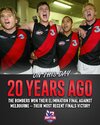Strapping Young Lad
Moderator
- Apr 19, 2006
- 103,621
- 264,301
- AFL Club
- Hawthorn
- Other Teams
- Storm, Spurs, Socceroos
- Thread starter
- Moderator
- #27,874
Notice :
Do not post names of players speculated to be involved in the sexual assault claims.
There has been a very clear suppression order put on anyone naming or speculating on players involved.
This is a site wide rule that must be followed.
Do not post names of players speculated to be involved in the sexual assault claims.
There has been a very clear suppression order put on anyone naming or speculating on players involved.
This is a site wide rule that must be followed.










